Draw a Diagram of the Unit Circle
To define our trigonometric functions, nosotros begin past drawing a unit circumvolve, a circumvolve centered at the origin with radius ane, equally shown in Figure 2. The angle (in radians) that [latex]t[/latex] intercepts forms an arc of length [latex]s[/latex]. Using the formula [latex]s=rt[/latex], and knowing that [latex]r=1[/latex], we see that for a unit circle, [latex]south=t[/latex].
Call up that the x- and y-axes divide the coordinate plane into four quarters called quadrants. We label these quadrants to mimic the direction a positive angle would sweep. The 4 quadrants are labeled I, Ii, III, and Iv.
For any angle [latex]t[/latex], we can label the intersection of the final side and the unit circle as past its coordinates, [latex]\left(ten,y\right)[/latex]. The coordinates [latex]x[/latex] and [latex]y[/latex] volition be the outputs of the trigonometric functions [latex]f\left(t\right)=\cos t[/latex] and [latex]f\left(t\right)=\sin t[/latex], respectively. This means [latex]x=\cos t[/latex] and [latex]y=\sin t[/latex].
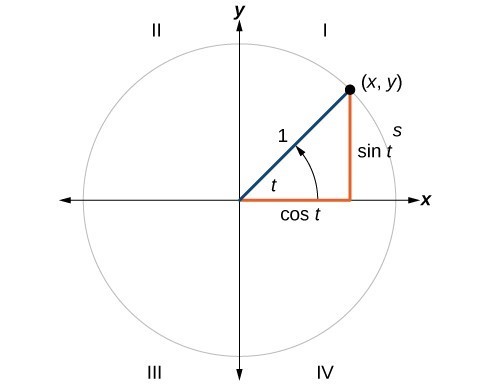
Effigy 2. Unit circle where the primal angle is [latex]t[/latex] radians
A General Note: Unit Circle
A unit circle has a center at [latex]\left(0,0\right)[/latex] and radius [latex]1[/latex] . In a unit of measurement circumvolve, the length of the intercepted arc is equal to the radian measure of the central angle [latex]i[/latex].
Let [latex]\left(ten,y\right)[/latex] be the endpoint on the unit circle of an arc of arc length [latex]s[/latex]. The [latex]\left(10,y\correct)[/latex] coordinates of this point can exist described as functions of the angle.
Defining Sine and Cosine Functions
Now that we have our unit circle labeled, we can larn how the [latex]\left(x,y\right)[/latex] coordinates relate to the arc length and angle. The sine part relates a real number [latex]t[/latex] to the y-coordinate of the betoken where the corresponding angle intercepts the unit of measurement circumvolve. More than precisely, the sine of an angle [latex]t[/latex] equals the y-value of the endpoint on the unit circle of an arc of length [latex]t[/latex]. In Figure 2, the sine is equal to [latex]y[/latex]. Like all functions, the sine part has an input and an output. Its input is the measure of the angle; its output is the y-coordinate of the corresponding signal on the unit of measurement circle.
The cosine part of an angle [latex]t[/latex] equals the x-value of the endpoint on the unit of measurement circle of an arc of length [latex]t[/latex]. In Figure three, the cosine is equal to [latex]ten[/latex].

Figure 3
Because information technology is understood that sine and cosine are functions, we practise not always need to write them with parentheses: [latex]\sin t[/latex] is the same as [latex]\sin \left(t\correct)[/latex] and [latex]\cos t[/latex] is the same as [latex]\cos \left(t\right)[/latex]. Likewise, [latex]{\cos }^{2}t[/latex] is a commonly used shorthand notation for [latex]{\left(\cos \left(t\right)\right)}^{2}[/latex]. Exist aware that many calculators and computers do non recognize the autograph note. When in doubt, use the extra parentheses when entering calculations into a estimator or calculator.
A General Note: Sine and Cosine Functions
If [latex]t[/latex] is a real number and a point [latex]\left(x,y\right)[/latex] on the unit circumvolve corresponds to an bending of [latex]t[/latex], then
[latex]\cos t=10[/latex]
[latex]\sin t=y[/latex]
How To: Given a point P [latex]\left(x,y\correct)[/latex] on the unit of measurement circle corresponding to an bending of [latex]t[/latex], find the sine and cosine.
- The sine of [latex]t[/latex] is equal to the y-coordinate of point [latex]P:\sin t=y[/latex].
- The cosine of [latex]t[/latex] is equal to the x-coordinate of point [latex]P: \text{cos}t=x[/latex].
Example i: Finding Function Values for Sine and Cosine
Point [latex]P[/latex] is a signal on the unit of measurement circle corresponding to an angle of [latex]t[/latex], as shown in Figure 4. Find [latex]\cos \left(t\right)\\[/latex] and [latex]\text{sin}\left(t\right)\\[/latex].
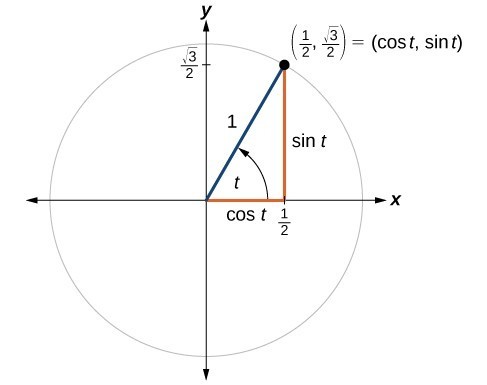
Figure 4
Solution
We know that [latex]\cos t[/latex] is the x-coordinate of the corresponding bespeak on the unit circle and [latex]\sin t[/latex] is the y-coordinate of the respective point on the unit circle. So:
[latex]\begin{assortment}{l}\begin{array}{l}\\ x=\cos t=\frac{1}{2}\end{array}\hfill \\ y=\sin t=\frac{\sqrt{3}}{2}\hfill \end{array}\\[/latex]
Try It 1
A certain angle [latex]t[/latex] corresponds to a betoken on the unit circle at [latex]\left(-\frac{\sqrt{2}}{2},\frac{\sqrt{2}}{ii}\right)\\[/latex] as shown in Figure 5. Find [latex]\cos t[/latex] and [latex]\sin t[/latex].

Figure 5
Solution
Finding Sines and Cosines of Angles on an Axis
For quadrantral angles, the corresponding point on the unit of measurement circle falls on the x- or y-axis. In that case, we can easily calculate cosine and sine from the values of [latex]10[/latex] and [latex]y[/latex].
Example 2: Calculating Sines and Cosines forth an Axis
Observe [latex]\cos \left(90^\circ \right)\\[/latex] and [latex]\text{sin}\left(90^\circ \correct)\\[/latex].
Solution
Moving [latex]90^\circ [/latex] counterclockwise around the unit circumvolve from the positive x-centrality brings us to the superlative of the circumvolve, where the [latex]\left(x,y\right)[/latex] coordinates are (0, i), as shown in Effigy 6.

Figure half dozen
Using our definitions of cosine and sine,
[latex]\begin{array}{l}10=\cos t=\cos \left(xc^\circ \right)=0\\ y=\sin t=\sin \left(90^\circ \correct)=1\end{array}\\[/latex]
The cosine of 90° is 0; the sine of 90° is 1.
Try Information technology 2
Find cosine and sine of the bending [latex]\pi [/latex].
Solution
The Pythagorean Identity
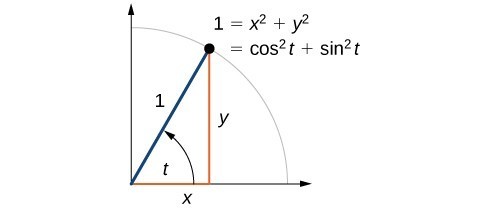
Figure 7
Now that we tin can define sine and cosine, we will acquire how they relate to each other and the unit of measurement circle. Recall that the equation for the unit circumvolve is [latex]{x}^{two}+{y}^{two}=1[/latex]. Because [latex]ten=\cos t[/latex] and [latex]y=\sin t[/latex], we can substitute for [latex]ten[/latex] and [latex]y[/latex] to get [latex]{\cos }^{2}t+{\sin }^{2}t=1[/latex]. This equation, [latex]{\cos }^{2}t+{\sin }^{2}t=1[/latex], is known as the Pythagorean Identity.
We can use the Pythagorean Identity to find the cosine of an angle if we know the sine, or vice versa. However, because the equation yields two solutions, we need additional cognition of the bending to choose the solution with the correct sign. If we know the quadrant where the angle is, we can easily choose the right solution.
A General Annotation: Pythagorean Identity
The Pythagorean Identity states that, for any existent number [latex]t[/latex],
[latex]{\cos }^{two}t+{\sin }^{2}t=1[/latex]
How To: Given the sine of some angle [latex]t[/latex] and its quadrant location, find the cosine of [latex]t[/latex].
- Substitute the known value of [latex]\sin \left(t\right)[/latex] into the Pythagorean Identity.
- Solve for [latex]\cos \left(t\right)[/latex].
- Choose the solution with the appropriate sign for the x-values in the quadrant where [latex]t[/latex] is located.
Instance 3: Finding a Cosine from a Sine or a Sine from a Cosine
If [latex]\sin \left(t\correct)=\frac{iii}{7}\\[/latex] and [latex]t[/latex] is in the 2nd quadrant, find [latex]\cos \left(t\right)\\[/latex].
Solution
If we driblet a vertical line from the bespeak on the unit of measurement circle corresponding to [latex]t[/latex], we create a right triangle, from which we tin run into that the Pythagorean Identity is just ane case of the Pythagorean Theorem.

Effigy 8
Substituting the known value for sine into the Pythagorean Identity,
[latex]\begin{assortment}{l}{\cos }^{2}\left(t\right)+{\sin }^{2}\left(t\right)=1\hfill \\ {\cos }^{2}\left(t\right)+\frac{9}{49}=1\hfill \\ {\cos }^{2}\left(t\correct)=\frac{40}{49}\hfill \\ \text{cos}\left(t\right)=\pm \sqrt{\frac{40}{49}}=\pm \frac{\sqrt{xl}}{7}=\pm \frac{2\sqrt{10}}{7}\hfill \end{array}\\[/latex]
Because the angle is in the second quadrant, we know the 10-value is a negative existent number, so the cosine is likewise negative. So
[latex]\text{cos}\left(t\right)=-\frac{2\sqrt{10}}{7}\\[/latex]
Endeavour Information technology 3
If [latex]\cos \left(t\right)=\frac{24}{25}\\[/latex] and [latex]t[/latex] is in the fourth quadrant, discover [latex]\text{sin}\left(t\right)\\[/latex].
Solution
Finding Sines and Cosines of Special Angles
We have already learned some backdrop of the special angles, such as the conversion from radians to degrees. We tin can also calculate sines and cosines of the special angles using the Pythagorean Identity and our knowledge of triangles.
Finding Sines and Cosines of 45° Angles
First, we volition await at angles of [latex]45^\circ [/latex] or [latex]\frac{\pi }{four}[/latex], as shown in Effigy nine. A [latex]45^\circ -45^\circ -90^\circ [/latex] triangle is an isosceles triangle, so the x- and y-coordinates of the corresponding point on the circumvolve are the same. Because the x- and y-values are the same, the sine and cosine values will also be equal.

Effigy 9
At [latex]t=\frac{\pi }{iv}[/latex] , which is 45 degrees, the radius of the unit circumvolve bisects the first quadrantal angle. This means the radius lies forth the line [latex]y=x[/latex]. A unit circle has a radius equal to 1. And so, the right triangle formed below the line [latex]y=x[/latex] has sides [latex]x[/latex] and [latex]y\text{ }\left(y=x\right)[/latex], and a radius = 1.
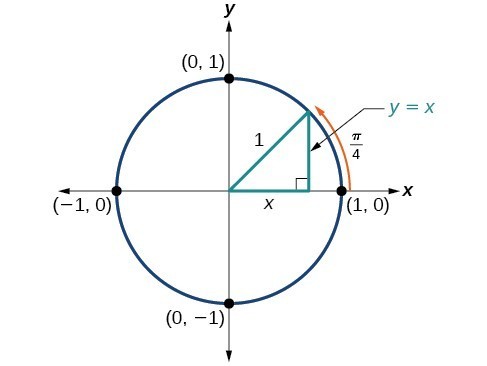
Effigy 10
From the Pythagorean Theorem we get
[latex]{x}^{2}+{y}^{2}=i[/latex]
Substituting [latex]y=10[/latex], we go
[latex]{ten}^{2}+{x}^{2}=i[/latex]
Combining similar terms nosotros go
[latex]2{10}^{two}=one[/latex]
And solving for [latex]x[/latex], nosotros get
[latex]\begin{array}{c}{x}^{2}=\frac{one}{2}\\ \text{ }10=\pm \frac{i}{\sqrt{2}}\stop{assortment}\\[/latex]
In quadrant I, [latex]x=\frac{1}{\sqrt{2}}\\[/latex].
At [latex]t=\frac{\pi }{4}[/latex] or 45 degrees,
[latex]\begin{array}{fifty}\left(x,y\right)=\left(ten,x\right)=\left(\frac{1}{\sqrt{ii}},\frac{1}{\sqrt{ii}}\correct)\hfill \\ x=\frac{1}{\sqrt{ii}},y=\frac{1}{\sqrt{2}}\hfill \\ \cos t=\frac{1}{\sqrt{2}},\sin t=\frac{1}{\sqrt{two}}\hfill \end{array}\\[/latex]
If we then rationalize the denominators, we become
[latex]\begin{array}{l}\cos t=\frac{1}{\sqrt{2}}\frac{\sqrt{2}}{\sqrt{two}}\hfill \\ =\frac{\sqrt{two}}{two}\hfill \\ \sin t=\frac{i}{\sqrt{2}}\frac{\sqrt{two}}{\sqrt{2}}\hfill \\ =\frac{\sqrt{2}}{2}\hfill \terminate{array}\\[/latex]
Therefore, the [latex]\left(x,y\right)\\[/latex] coordinates of a point on a circumvolve of radius [latex]1[/latex] at an angle of [latex]45^\circ [/latex] are [latex]\left(\frac{\sqrt{2}}{ii},\frac{\sqrt{two}}{2}\right)\\[/latex].
Finding Sines and Cosines of thirty° and 60° Angles
Adjacent, nosotros volition find the cosine and sine at an angle of [latex]xxx^\circ [/latex], or [latex]\frac{\pi }{half-dozen}\\[/latex] . First, we volition draw a triangle inside a circle with i side at an angle of [latex]30^\circ [/latex], and another at an bending of [latex]-30^\circ [/latex], as shown in Figure 11. If the resulting 2 correct triangles are combined into one big triangle, notice that all iii angles of this larger triangle will be [latex]sixty^\circ [/latex], as shown in Figure 12.
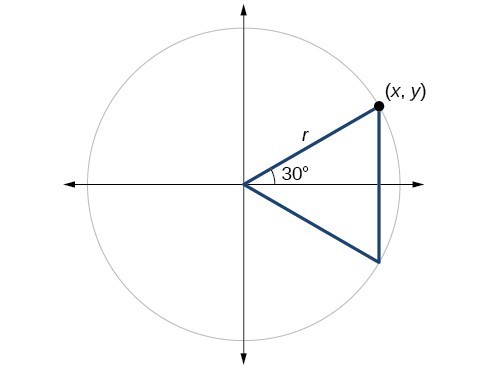
Figure eleven

Figure 12
Because all the angles are equal, the sides are also equal. The vertical line has length [latex]2y[/latex], and since the sides are all equal, nosotros tin can besides conclude that [latex]r=2y[/latex] or [latex]y=\frac{1}{two}r[/latex]. Since [latex]\sin t=y[/latex] ,
[latex]\sin \left(\frac{\pi }{6}\right)=\frac{1}{2}r\\[/latex]
And since [latex]r=1[/latex] in our unit circumvolve,
[latex]\brainstorm{array}{l}\sin \left(\frac{\pi }{6}\right)=\frac{1}{2}\left(1\right)\hfill \\ \text{ }=\frac{one}{2}\hfill \end{array}\\[/latex]
Using the Pythagorean Identity, we can observe the cosine value.
[latex]\begin{array}{ll}{\cos }^{ii}\frac{\pi }{half-dozen}+{\sin }^{two}\left(\frac{\pi }{6}\right)=1\hfill & \hfill \\ \text{ }{\cos }^{two}\left(\frac{\pi }{6}\right)+{\left(\frac{1}{ii}\right)}^{ii}=ane\hfill & \hfill \\ \text{ }{\cos }^{two}\left(\frac{\pi }{6}\right)=\frac{3}{4}\hfill & \text{Use the square root property}.\hfill \\ \text{ }\cos \left(\frac{\pi }{6}\right)=\frac{\pm \sqrt{iii}}{\pm \sqrt{four}}=\frac{\sqrt{3}}{2}\hfill & \text{Since }y\text{ is positive, choose the positive root}.\hfill \end{array}\\[/latex]
The [latex]\left(x,y\correct)[/latex] coordinates for the point on a circle of radius [latex]1[/latex] at an bending of [latex]30^\circ [/latex] are [latex]\left(\frac{\sqrt{3}}{2},\frac{1}{2}\correct)\\[/latex]. At [latex]t=\frac{\pi }{3}[/latex] (60°), the radius of the unit of measurement circle, i, serves as the hypotenuse of a thirty-60-90 degree right triangle, [latex]BAD[/latex], every bit shown in [link]. Angle [latex]A[/latex] has measure [latex]60^\circ [/latex]. At betoken [latex]B[/latex], we describe an angle [latex]ABC[/latex] with mensurate of [latex]threescore^\circ [/latex]. Nosotros know the angles in a triangle sum to [latex]180^\circ [/latex], and so the measure of angle [latex]C[/latex] is also [latex]60^\circ [/latex]. Now nosotros accept an equilateral triangle. Because each side of the equilateral triangle [latex]ABC[/latex] is the same length, and we know 1 side is the radius of the unit circle, all sides must be of length i.

Effigy 13
The measure out of angle [latex]ABD[/latex] is 30°. So, if double, bending [latex]ABC[/latex] is 60°. [latex]BD[/latex] is the perpendicular bisector of [latex]AC[/latex], so information technology cuts [latex]Ac[/latex] in half. This means that [latex]Advertizement[/latex] is [latex]\frac{ane}{2}[/latex] the radius, or [latex]\frac{1}{2}[/latex]. Notice that [latex]AD[/latex] is the x-coordinate of point [latex]B[/latex], which is at the intersection of the 60° angle and the unit circle. This gives u.s. a triangle [latex]BAD[/latex] with hypotenuse of 1 and side [latex]ten[/latex] of length [latex]\frac{1}{ii}\\[/latex].
From the Pythagorean Theorem, we go
[latex]{ten}^{ii}+{y}^{2}=i[/latex]
Substituting [latex]x=\frac{1}{2}[/latex], we become
[latex]{\left(\frac{1}{2}\right)}^{2}+{y}^{ii}=one[/latex]
Solving for [latex]y[/latex], nosotros get
[latex]\begin{array}{50}\frac{1}{4}+{y}^{2}=1\\ \text{ }{y}^{2}=one-\frac{1}{four}\\ \text{ }{y}^{2}=\frac{three}{iv}\\ \text{ }y=\pm \frac{\sqrt{3}}{ii}\end{array}\\[/latex]
Since [latex]t=\frac{\pi }{3}[/latex] has the last side in quadrant I where the y-coordinate is positive, we choose [latex]y=\frac{\sqrt{3}}{ii}\\[/latex], the positive value.
At [latex]t=\frac{\pi }{3}\\[/latex] (60°), the [latex]\left(ten,y\right)[/latex] coordinates for the bespeak on a circumvolve of radius [latex]ane[/latex] at an bending of [latex]sixty^\circ [/latex] are [latex]\left(\frac{one}{ii},\frac{\sqrt{3}}{2}\right)\\[/latex], then we can find the sine and cosine.
[latex]\begin{array}{50}\left(x,y\right)=\left(\frac{ane}{ii},\frac{\sqrt{iii}}{ii}\right)\hfill \\ x=\frac{ane}{2},y=\frac{\sqrt{3}}{two}\hfill \\ \cos t=\frac{1}{2},\sin t=\frac{\sqrt{3}}{ii}\hfill \terminate{array}\\[/latex]
We have now institute the cosine and sine values for all of the most ordinarily encountered angles in the first quadrant of the unit circle. The table beneath summarizes these values.
| Bending | 0 | [latex]\frac{\pi }{6}\\[/latex], or 30 | [latex]\frac{\pi }{4}\\[/latex], or 45° | [latex]\frac{\pi }{iii}\\[/latex], or lx° | [latex]\frac{\pi }{two}\\[/latex], or ninety° |
| Cosine | 1 | [latex]\frac{\sqrt{3}}{two}\\[/latex] | [latex]\frac{\sqrt{2}}{2}\\[/latex] | [latex]\frac{1}{2}\\[/latex] | 0 |
| Sine | 0 | [latex]\frac{1}{2}\\[/latex] | [latex]\frac{\sqrt{two}}{two}\\[/latex] | [latex]\frac{\sqrt{3}}{two}\\[/latex] | one |
Figure fourteen shows the common angles in the outset quadrant of the unit circle.

Figure xiv
Using a Calculator to Find Sine and Cosine
To observe the cosine and sine of angles other than the special angles, we turn to a computer or reckoner. Be enlightened: Almost calculators can be set into "degree" or "radian" mode, which tells the computer the units for the input value. When we evaluate [latex]\cos \left(30\correct)[/latex] on our calculator, it volition evaluate information technology equally the cosine of 30 degrees if the calculator is in degree fashion, or the cosine of 30 radians if the reckoner is in radian mode.
How To: Given an bending in radians, use a graphing computer to find the cosine.
- If the calculator has caste manner and radian mode, set it to radian way.
- Press the COS key.
- Enter the radian value of the angle and press the close-parentheses key ")".
- Press ENTER.
Instance four: Using a Graphing Reckoner to Find Sine and Cosine
Evaluate [latex]\cos \left(\frac{5\pi }{three}\right)\\[/latex] using a graphing calculator or reckoner.
Solution
Enter the following keystrokes:
COS (5 × π ÷ 3 ) ENTER
[latex]\cos \left(\frac{5\pi }{3}\right)=0.5\\[/latex]
Analysis of the Solution
We can detect the cosine or sine of an angle in degrees directly on a estimator with degree mode. For calculators or software that use only radian fashion, nosotros tin can find the sign of [latex]xx^\circ [/latex], for case, by including the conversion gene to radians every bit role of the input:
SIN( twenty × π ÷ 180 ) ENTER
Endeavour Information technology four
Evaluate [latex]\sin \left(\frac{\pi }{3}\right)\\[/latex].
Solution
Identifying the Domain and Range of Sine and Cosine Functions
At present that we tin detect the sine and cosine of an angle, we need to discuss their domains and ranges. What are the domains of the sine and cosine functions? That is, what are the smallest and largest numbers that can exist inputs of the functions? Because angles smaller than 0 and angles larger than [latex]2\pi [/latex] can withal be graphed on the unit circumvolve and have real values of [latex]x,y[/latex], and [latex]r[/latex], there is no lower or upper limit to the angles that can be inputs to the sine and cosine functions. The input to the sine and cosine functions is the rotation from the positive x-axis, and that may be any existent number.
What are the ranges of the sine and cosine functions? What are the least and greatest possible values for their output? We can run into the answers past examining the unit of measurement circumvolve, as shown in Figure 15. The bounds of the ten-coordinate are [latex]\left[-ane,1\right][/latex]. The bounds of the y-coordinate are also [latex]\left[-1,ane\right][/latex]. Therefore, the range of both the sine and cosine functions is [latex]\left[-i,ane\right][/latex].

Effigy 15
Nosotros have discussed finding the sine and cosine for angles in the first quadrant, but what if our angle is in another quadrant? For any given angle in the outset quadrant, there is an angle in the 2d quadrant with the same sine value. Considering the sine value is the y-coordinate on the unit of measurement circumvolve, the other angle with the same sine will share the same y-value, only have the opposite ten-value. Therefore, its cosine value will exist the opposite of the first angle's cosine value.
Also, at that place will exist an bending in the fourth quadrant with the same cosine as the original angle. The angle with the aforementioned cosine volition share the same x-value simply volition have the opposite y-value. Therefore, its sine value will exist the opposite of the original bending's sine value.
As shown in Figure 16, angle [latex]\alpha [/latex] has the aforementioned sine value as angle [latex]t[/latex]; the cosine values are opposites. Bending [latex]\beta [/latex] has the same cosine value every bit angle [latex]t[/latex]; the sine values are opposites.
[latex]\begin{assortment}{lll}\sin \left(t\correct)=\sin \left(\blastoff \correct)\hfill & \text{and}\hfill & \cos \left(t\right)=-\cos \left(\alpha \correct)\hfill \\ \sin \left(t\right)=-\sin \left(\beta \right)\hfill & \text{and}\hfill & \cos \left(t\right)=\cos \left(\beta \right)\hfill \stop{array}[/latex]

Figure 16
Call up that an angle's reference angle is the acute angle, [latex]t[/latex], formed by the concluding side of the angle [latex]t[/latex] and the horizontal axis. A reference bending is ever an angle betwixt [latex]0[/latex] and [latex]xc^\circ [/latex], or [latex]0[/latex] and [latex]\frac{\pi }{2}[/latex] radians. As we tin see from Figure 17, for any angle in quadrants Ii, Iii, or Four, in that location is a reference bending in quadrant I.

Effigy 17
How To: Given an angle between [latex]0[/latex] and [latex]2\pi [/latex], find its reference angle.
- An angle in the first quadrant is its own reference angle.
- For an bending in the second or 3rd quadrant, the reference bending is [latex]|\pi -t|[/latex] or [latex]|180^\circ \mathrm{-t}|[/latex].
- For an angle in the quaternary quadrant, the reference bending is [latex]2\pi -t[/latex] or [latex]360^\circ \mathrm{-t}[/latex].
- If an angle is less than [latex]0[/latex] or greater than [latex]ii\pi [/latex], add or subtract [latex]two\pi [/latex] every bit many times as needed to find an equivalent bending between [latex]0[/latex] and [latex]2\pi [/latex].
Example 5: Finding a Reference Angle
Notice the reference angle of [latex]225^\circ [/latex] as shown in Effigy 18.

Figure xviii
Solution
Because [latex]225^\circ [/latex] is in the third quadrant, the reference bending is
[latex]|\left(180^\circ -225^\circ \correct)|=|-45^\circ |=45^\circ [/latex]
Try Information technology 5
Find the reference angle of [latex]\frac{5\pi }{iii}[/latex].
Solution
Using Reference Angles
Now let'south accept a moment to reconsider the Ferris wheel introduced at the beginning of this section. Suppose a rider snaps a photograph while stopped twenty anxiety higher up ground level. The rider then rotates iii-quarters of the fashion effectually the circle. What is the rider's new elevation? To answer questions such as this one, we need to evaluate the sine or cosine functions at angles that are greater than 90 degrees or at a negative angle. Reference angles make information technology possible to evaluate trigonometric functions for angles outside the start quadrant. They can too be used to find [latex]\left(x,y\right)[/latex] coordinates for those angles. We volition use the reference bending of the bending of rotation combined with the quadrant in which the terminal side of the angle lies.
Using Reference Angles to Evaluate Trigonometric Functions
We can find the cosine and sine of any angle in any quadrant if we know the cosine or sine of its reference bending. The absolute values of the cosine and sine of an angle are the aforementioned every bit those of the reference angle. The sign depends on the quadrant of the original bending. The cosine will exist positive or negative depending on the sign of the x-values in that quadrant. The sine volition be positive or negative depending on the sign of the y-values in that quadrant.
A General Annotation: Using Reference Angles to Find Cosine and Sine
Angles have cosines and sines with the aforementioned absolute value as their reference angles. The sign (positive or negative) can be determined from the quadrant of the angle.
How To: Given an angle in standard position, find the reference angle, and the cosine and sine of the original angle.
- Mensurate the angle between the terminal side of the given bending and the horizontal axis. That is the reference angle.
- Determine the values of the cosine and sine of the reference angle.
- Give the cosine the same sign every bit the x-values in the quadrant of the original bending.
- Give the sine the same sign every bit the y-values in the quadrant of the original angle.
Example v: Using Reference Angles to Find Sine and Cosine
- Using a reference angle, discover the exact value of [latex]\cos \left(150^\circ \right)[/latex] and [latex]\text{sin}\left(150^\circ \right)[/latex].
- Using the reference angle, find [latex]\cos \frac{5\pi }{4}[/latex] and [latex]\sin \frac{five\pi }{4}[/latex].
Solution
- 150° is located in the second quadrant. The bending information technology makes with the x-axis is 180° − 150° = 30°, so the reference angle is 30°.This tells u.s.a. that 150° has the same sine and cosine values as 30°, except for the sign. Nosotros know that
[latex]\cos \left(thirty^\circ \right)=\frac{\sqrt{3}}{ii}\text{and}\sin \left(30^\circ \correct)=\frac{one}{ii}[/latex].
Since 150° is in the 2nd quadrant, the x-coordinate of the point on the circumvolve is negative, and so the cosine value is negative. The y-coordinate is positive, then the sine value is positive.
[latex]\cos \left(150^\circ \right)=-\frac{\sqrt{iii}}{2}\text{and}\sin \left(150^\circ \right)=\frac{1}{2}[/latex]
- [latex]\frac{v\pi }{4}[/latex] is in the third quadrant. Its reference bending is [latex]\frac{5\pi }{four}-\pi =\frac{\pi }{4}[/latex]. The cosine and sine of [latex]\frac{\pi }{four}[/latex] are both [latex]\frac{\sqrt{2}}{2}[/latex]. In the tertiary quadrant, both [latex]x[/latex] and [latex]y[/latex] are negative, then:
[latex]\cos \frac{five\pi }{4}=-\frac{\sqrt{2}}{two}\text{and}\sin \frac{5\pi }{iv}=-\frac{\sqrt{2}}{2}[/latex]
Attempt It 6
a. Use the reference angle of [latex]315^\circ [/latex] to find [latex]\cos \left(315^\circ \right)[/latex] and [latex]\sin \left(315^\circ \correct)[/latex].
b. Employ the reference angle of [latex]-\frac{\pi }{half dozen}[/latex] to find [latex]\cos \left(-\frac{\pi }{6}\right)[/latex] and [latex]\sin \left(-\frac{\pi }{6}\right)[/latex].
Using Reference Angles to Find Coordinates
Now that we have learned how to detect the cosine and sine values for special angles in the first quadrant, we can utilize symmetry and reference angles to fill in cosine and sine values for the rest of the special angles on the unit circumvolve. They are shown in Figure 19. Accept fourth dimension to learn the [latex]\left(x,y\correct)[/latex] coordinates of all of the major angles in the first quadrant.

In add-on to learning the values for special angles, we tin utilise reference angles to discover [latex]\left(10,y\correct)[/latex] coordinates of any point on the unit circle, using what nosotros know of reference angles along with the identities
[latex]\begin{array}{l}ten=\cos t\hfill \\ y=\sin t\hfill \end{array}[/latex]
First we find the reference angle corresponding to the given bending. Then we take the sine and cosine values of the reference angle, and give them the signs corresponding to the y– and ten-values of the quadrant.
How To: Given the bending of a indicate on a circle and the radius of the circle, notice the [latex]\left(x,y\right)[/latex] coordinates of the point.
- Observe the reference angle by measuring the smallest angle to the 10-axis.
- Find the cosine and sine of the reference angle.
- Decide the appropriate signs for [latex]x[/latex] and [latex]y[/latex]
in the given quadrant.
Example vi: Using the Unit of measurement Circle to Notice Coordinates
Notice the coordinates of the indicate on the unit circumvolve at an angle of [latex]\frac{7\pi }{6}[/latex].
Solution
Nosotros know that the bending [latex]\frac{7\pi }{half-dozen}[/latex] is in the third quadrant.
Outset, permit'south notice the reference angle by measuring the angle to the ten-centrality. To notice the reference angle of an angle whose final side is in quadrant Iii, nosotros find the difference of the angle and [latex]\pi [/latex].
[latex]\frac{seven\pi }{half dozen}-\pi =\frac{\pi }{6}[/latex]
Next, nosotros will discover the cosine and sine of the reference bending:
[latex]\cos \left(\frac{\pi }{6}\right)=\frac{\sqrt{three}}{2}\sin \left(\frac{\pi }{6}\right)=\frac{ane}{2}[/latex]
We must make up one's mind the appropriate signs for x and y in the given quadrant. Because our original angle is in the third quadrant, where both [latex]x[/latex] and [latex]y[/latex] are negative, both cosine and sine are negative.
[latex]\brainstorm{array}{fifty}\cos \left(\frac{7\pi }{6}\right)=-\frac{\sqrt{3}}{2}\hfill \\ \sin \left(\frac{vii\pi }{half-dozen}\right)=-\frac{ane}{two}\hfill \end{array}[/latex]
Now nosotros can calculate the [latex]\left(10,y\right)[/latex] coordinates using the identities [latex]ten=\cos \theta [/latex] and [latex]y=\sin \theta [/latex].
The coordinates of the betoken are [latex]\left(-\frac{\sqrt{iii}}{2},-\frac{1}{2}\right)[/latex] on the unit of measurement circle.
Try It 7
Discover the coordinates of the point on the unit circle at an angle of [latex]\frac{v\pi }{iii}[/latex].
Solution
Key Equations
| Cosine | [latex]\cos t=x[/latex] |
| Sine | [latex]\sin t=y[/latex] |
| Pythagorean Identity | [latex]{\cos }^{two}t+{\sin }^{2}t=1[/latex] |
Central Concepts
- Finding the function values for the sine and cosine begins with drawing a unit circle, which is centered at the origin and has a radius of 1 unit.
- Using the unit circle, the sine of an angle [latex]t[/latex] equals the y-value of the endpoint on the unit circumvolve of an arc of length [latex]t[/latex] whereas the cosine of an bending [latex]t[/latex] equals the x-value of the endpoint.
- The sine and cosine values are near direct adamant when the corresponding point on the unit of measurement circumvolve falls on an axis.
- When the sine or cosine is known, nosotros can use the Pythagorean Identity to find the other. The Pythagorean Identity is also useful for determining the sines and cosines of special angles.
- Calculators and graphing software are helpful for finding sines and cosines if the proper procedure for inbound information is known.
- The domain of the sine and cosine functions is all existent numbers.
- The range of both the sine and cosine functions is [latex]\left[-i,ane\right][/latex].
- The sine and cosine of an angle accept the aforementioned accented value every bit the sine and cosine of its reference angle.
- The signs of the sine and cosine are determined from the x– and y-values in the quadrant of the original angle.
- An angle'south reference angle is the size bending, [latex]t[/latex],
formed by the terminal side of the angle [latex]t[/latex] and the horizontal axis. - Reference angles can be used to find the sine and cosine of the original bending.
- Reference angles tin can too be used to find the coordinates of a betoken on a circle.
Glossary
- cosine part
- the 10-value of the indicate on a unit of measurement circle corresponding to a given angle
- Pythagorean Identity
- a corollary of the Pythagorean Theorem stating that the foursquare of the cosine of a given angle plus the square of the sine of that angle equals 1
- sine function
- the y-value of the indicate on a unit circumvolve corresponding to a given angle
- unit of measurement circle
- a circle with a center at [latex]\left(0,0\right)[/latex]
and radius
Department Exercises
- 1. Depict the unit of measurement circle.
- two. What do the ten- and y-coordinates of the points on the unit of measurement circle stand for?
iii. Talk over the difference between a coterminal angle and a reference angle.
4. Explicate how the cosine of an bending in the 2nd quadrant differs from the cosine of its reference bending in the unit circle.
five. Explain how the sine of an bending in the 2nd quadrant differs from the sine of its reference angle in the unit circle.
For the following exercises, use the given sign of the sine and cosine functions to find the quadrant in which the concluding bespeak determined by [latex]t[/latex] lies.
half-dozen. [latex]\text{sin}\left(t\right)<0[/latex] and [latex]\text{cos}\left(t\right)<0[/latex]
seven. [latex]\text{sin}\left(t\right)>0[/latex] and [latex]\cos \left(t\right)>0[/latex]
8. [latex]\sin \left(t\right)>0[/latex] and [latex]\cos \left(t\right)<0[/latex]
nine. [latex]\sin \left(t\correct)<0[/latex] and [latex]\cos \left(t\right)>0[/latex]
For the following exercises, discover the exact value of each trigonometric function.
ten. [latex]\sin \frac{\pi }{two}[/latex]
11. [latex]\sin \frac{\pi }{iii}[/latex]
12. [latex]\cos \frac{\pi }{two}[/latex]
13. [latex]\cos \frac{\pi }{three}[/latex]
xiv. [latex]\sin \frac{\pi }{4}[/latex]
15. [latex]\cos \frac{\pi }{4}[/latex]
sixteen. [latex]\sin \frac{\pi }{half dozen}[/latex]
17. [latex]\sin \pi [/latex]
18. [latex]\sin \frac{iii\pi }{2}[/latex]
nineteen. [latex]\cos \pi [/latex]
twenty. [latex]\cos 0[/latex]
21. [latex]\cos \frac{\pi }{6}[/latex]
22. [latex]\sin 0[/latex]
For the post-obit exercises, state the reference angle for the given angle.
23. [latex]240^\circ [/latex]
24. [latex]-170^\circ [/latex]
25. [latex]100^\circ [/latex]
26. [latex]-315^\circ [/latex]
27. [latex]135^\circ [/latex]
28. [latex]\frac{5\pi }{four}[/latex]
29. [latex]\frac{two\pi }{3}[/latex]
30. [latex]\frac{5\pi }{6}[/latex]
31. [latex]\frac{-11\pi }{3}[/latex]
32. [latex]\frac{-7\pi }{4}[/latex]
33. [latex]\frac{-\pi }{8}[/latex]
For the following exercises, observe the reference angle, the quadrant of the terminal side, and the sine and cosine of each bending. If the angle is not one of the angles on the unit circumvolve, utilise a calculator and circular to 3 decimal places.
34. [latex]225^\circ [/latex]
35. [latex]300^\circ [/latex]
36. [latex]320^\circ [/latex]
37. [latex]135^\circ [/latex]
38. [latex]210^\circ [/latex]
39. [latex]120^\circ [/latex]
40. [latex]250^\circ [/latex]
41. [latex]150^\circ [/latex]
42. [latex]\frac{5\pi }{4}[/latex]
43. [latex]\frac{7\pi }{6}[/latex]
44. [latex]\frac{five\pi }{three}[/latex]
45. [latex]\frac{3\pi }{4}[/latex]
46. [latex]\frac{4\pi }{3}[/latex]
47. [latex]\frac{two\pi }{iii}[/latex]
48. [latex]\frac{five\pi }{6}[/latex]
49. [latex]\frac{7\pi }{4}[/latex]
For the following exercises, notice the requested value.
fifty. If [latex]\text{cos}\left(t\correct)=\frac{one}{seven}[/latex] and [latex]t[/latex] is in the ivth quadrant, find [latex]\text{sin}\left(t\right)[/latex].
51. If [latex]\text{cos}\left(t\correct)=\frac{2}{ix}[/latex] and [latex]t[/latex] is in the onest quadrant, find [latex]\text{sin}\left(t\correct)[/latex].
52. If [latex]\text{sin}\left(t\right)=\frac{three}{viii}[/latex] and [latex]t[/latex] is in the 2nd quadrant, find [latex]\text{cos}\left(t\correct)[/latex].
53. If [latex]\text{sin}\left(t\right)=-\frac{one}{iv}[/latex] and [latex]t[/latex] is in the 3rd quadrant, detect [latex]\text{cos}\left(t\right)[/latex].
54. Observe the coordinates of the signal on a circle with radius xv corresponding to an angle of [latex]220^\circ [/latex].
55. Detect the coordinates of the indicate on a circle with radius 20 corresponding to an angle of [latex]120^\circ [/latex].
56. Detect the coordinates of the indicate on a circle with radius 8 corresponding to an angle of [latex]\frac{7\pi }{4}[/latex].
57. Find the coordinates of the point on a circle with radius 16 respective to an angle of [latex]\frac{5\pi }{9}[/latex].
58. Country the domain of the sine and cosine functions.
59. Country the range of the sine and cosine functions.
For the following exercises, use the given point on the unit circle to observe the value of the sine and cosine of [latex]t[/latex].
60.

61.

62.

63.

64.

65.

66.

67.

68.

69.

seventy.

71.

72.

73.

74.

75.

76.

77.

78.

79.

For the following exercises, apply a graphing figurer to evaluate.fourscore. [latex]\sin \frac{5\pi }{9}[/latex]
81. [latex]\cos \frac{5\pi }{9}[/latex]
82. [latex]\sin \frac{\pi }{x}[/latex]
83. [latex]\cos \frac{\pi }{10}[/latex]
84. [latex]\sin \frac{3\pi }{4}[/latex]
85. [latex]\cos \frac{3\pi }{4}[/latex]
86. [latex]\sin 98^\circ [/latex]
87. [latex]\cos 98^\circ [/latex]
88. [latex]\cos 310^\circ [/latex]
89. [latex]\sin 310^\circ [/latex]
90. [latex]\sin \left(\frac{11\pi }{three}\right)\cos \left(\frac{-five\pi }{six}\right)[/latex]
91. [latex]\sin \left(\frac{3\pi }{4}\right)\cos \left(\frac{five\pi }{3}\right)[/latex]
92. [latex]\sin \left(-\frac{four\pi }{3}\right)\cos \left(\frac{\pi }{2}\right)[/latex]
93. [latex]\sin \left(\frac{-9\pi }{4}\correct)\cos \left(\frac{-\pi }{6}\correct)[/latex]
94. [latex]\sin \left(\frac{\pi }{6}\right)\cos \left(\frac{-\pi }{3}\right)[/latex]
95. [latex]\sin \left(\frac{7\pi }{4}\right)\cos \left(\frac{-2\pi }{3}\right)[/latex]
96. [latex]\cos \left(\frac{5\pi }{6}\correct)\cos \left(\frac{ii\pi }{3}\right)[/latex]
97. [latex]\cos \left(\frac{-\pi }{3}\correct)\cos \left(\frac{\pi }{4}\right)[/latex]
98. [latex]\sin \left(\frac{-5\pi }{4}\correct)\sin \left(\frac{11\pi }{6}\right)[/latex]
99. [latex]\sin \left(\pi \right)\sin \left(\frac{\pi }{6}\right)[/latex]
For the post-obit exercises, use this scenario: A child enters a carousel that takes ane minute to revolve one time around. The kid enters at the point [latex]\left(0,1\correct)[/latex], that is, on the due northward position. Assume the carousel revolves counter clockwise.
100. What are the coordinates of the child after 45 seconds?
101. What are the coordinates of the child later 90 seconds?
102. What is the coordinates of the child later 125 seconds?
103. When will the kid accept coordinates [latex]\left(0.707,-0.707\right)[/latex] if the ride lasts 6 minutes? (There are multiple answers.)
104. When will the child accept coordinates [latex]\left(-0.866,-0.v\right)[/latex] if the ride concluding 6 minutes?
Source: https://courses.lumenlearning.com/precalctwo/chapter/unit-circle-sine-and-cosine-functions/
0 Response to "Draw a Diagram of the Unit Circle"
Post a Comment